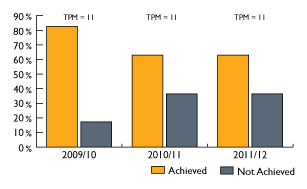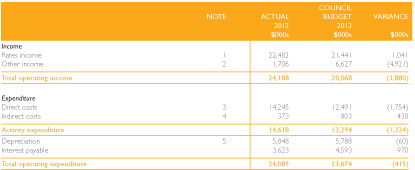At a Glance
Primary Services
- Water treatment and reticulation
Why We Do It
- Council's vision is for everybody in the Far North to have access to sufficient, safe, and reliable sources of drinking water that is provided in a sustainable manner. The water treatment plants, pumping stations, and reticulation systems contribute to that by providing the treatment and delivery of safe drinking water to communities served by Council owned systems.
- Water supply is regarded as one of the core functions of Council, as provided by statute. The Local Government Act 2002 generally requires the continued operation of any water system that Council operated at the time the Act was passed, as well as continuing to operate any new system that Council constructs from that date.
What Has Changed Since The LTCCP 2009/19?
- New reservoirs were not required to be constructed to meet demand. However, this will be subject to future growth forecasting.
- The Omanaia new water supply will be progressed following community consultation.
Priorities For 2011/12 |
What We Have / Haven't Achieved |
|---|---|
| Reviewing options for the supply of water | The drought of 2010 caused Council to review its water strategy across the district in view of the last comparable period of low rainfall occurring in the 1980's. One of the most seriously affected communities was Kaitaia where river flows reached historical low levels and the Kauri dam, due to its small size became unusable due to algae bloom derived from the natural environment and the high water temperatures. Council has applied for, and has been granted the resource consent to draw from the Aupouri Aquifier and we are now actively planning to complete the well head and pipeline project in 2013. Council has upgraded the capacity of the Kerikeri water treatment plant to maximise the capability to treat the available raw water supply. Council has work planned to increase the capacity of the Paihia treatment plant. Development of the Omania-Rawene reticulation and treatment capacity has not taken place despite consultation with the affected community. Community concern over the cost of providing potable water to the approximately 50 households involved and the conditions governing the availability of the subsidy has deferred further progress. |
| Providing a secure water source for Kaitaia | Council has obtained resource consent to extract water from the Sweetwater aquifer. A project to install borehole supplies and transmission to the public system has been approved to proceed under a BOOT (build, own, operate & transfer) project. |
| Limiting extensions to reticulation in line with falling demand from new development | There have been limited numbers of new connections in line with current development requirements. |
| Reducing operating costs | Operating costs have been maintained within budget and below current inflation rates, despite high increases experienced in energy costs. |
| Investigating rain water harvesting at Opononi / Omapere | Detailed investigations and analysis are still required to better understand the benefits, funding requirements and ratepayer impacts, expected to be undertaken during the next period. |
| Introduction of a bylaw for rainwater tanks on new properties | The rainwater tank bylaw has not been formally introduced although it is expected that it will be developed over the next period. |
Future Issues / Challenges |
Implications |
|---|---|
| Climate change, which threatens to increase the likelihood of droughts and future water shortages | Requires water conservation measures, community education about water conservation, and action to secure future supplies. Council must take steps to reduce levels of water lost from its systems through leakage and unauthorised use. |
| Higher environmental standards - resource consents will impose tighter restrictions on the amount of water we can take from rivers and streams | Review adequacy of water sources and possible requirements for additional future supplies and / or engage with communities to identify other solutions that will reduce demand for non potable water use. |
| Increased demand for the service as a result of the growth of the district and of tourism | Requires upgrades of systems and provision of additional infrastructure in conjunction with growth - possible new treatment plants, treatment plant upgrades, additional treated water reservoirs, bores, and upgraded reticulation. |
| Increasing operating costs (power, fuels and chemicals) | Requires cost management via leakage reduction, water conservation, planned maintenance, and power and fuel management. |
| Meeting latest New Zealand fire fighting water supplies standard | Requires improved flow rates in urban / commercial areas. |
| Raw water connections on the Omanaia-Rawene and Kaitaia schemes posing a potential risk to public health | Review of options to mitigate potential risks. Collaboration with users to ensure sustainable solutions. |
Highlights of Performance

TPM = Total number of Performance Measures
 Performance 2010/11 vs. 2011/12 - has improved
Performance 2010/11 vs. 2011/12 - has improved
Statement of Service Performance
For WATER SUPPLY the following pages detail:- Service performance information provides levels of service comparative results for 2010/11 and 2011/12 including achievements and issues.
- Financial performance including comparisons against budget 2011/12.
 Print the above sections
Print the above sections

